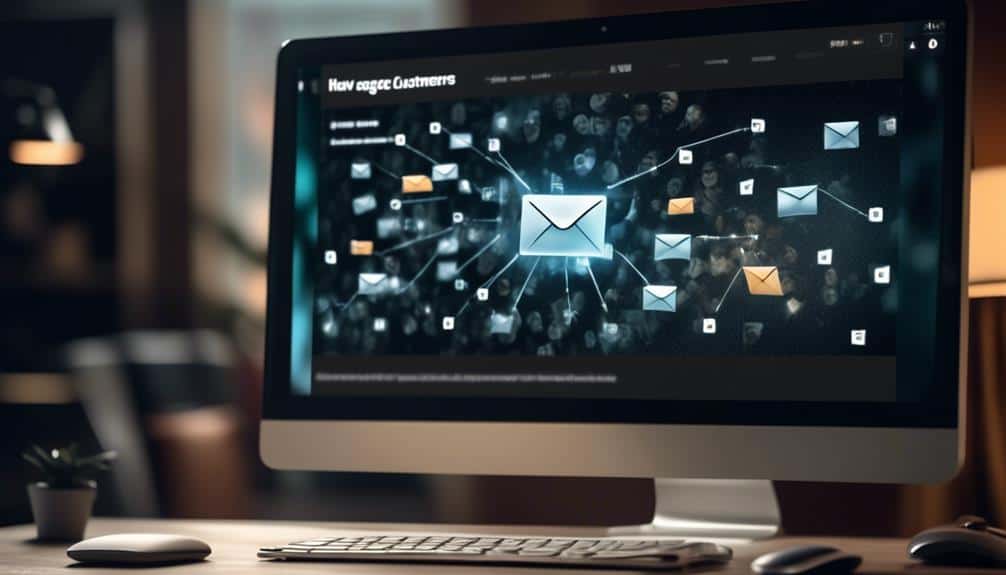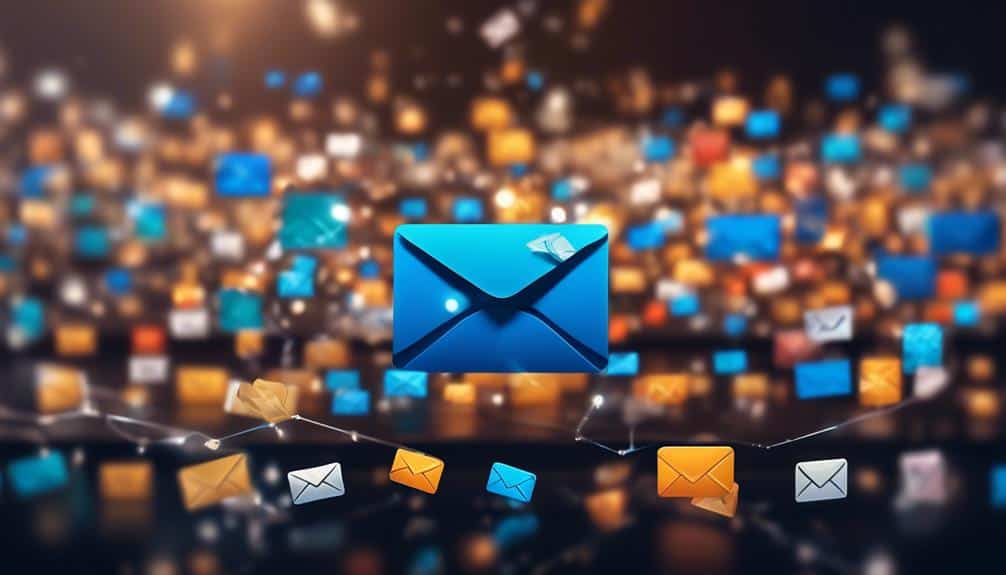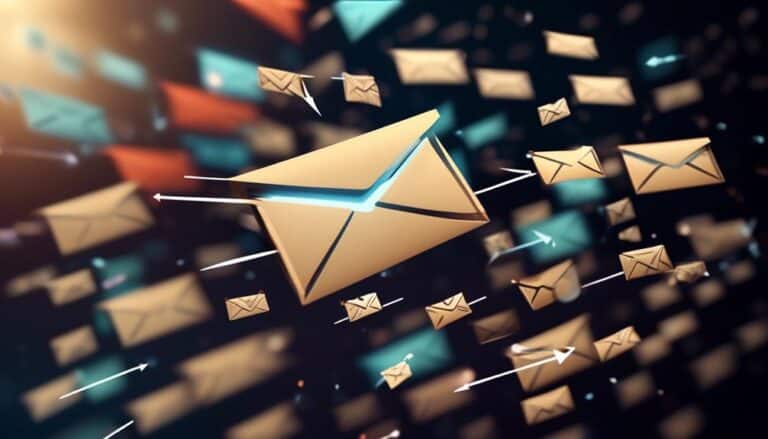Unlock Now: The Power of Email List Segmentation You Can’t Afford to Ignore
Do you know that businesses that use email list segmentation have been found to achieve 14.31% higher open rates and 100.95% higher click-through rates compared to non-segmented campaigns? It's a staggering statistic that highlights the power of email list segmentation in optimizing your email marketing efforts.
But what exactly is email list segmentation and why is it essential for your business? In this discussion, we will explore the benefits of email list segmentation, how to effectively segment your list, and the key to successful personalization.
Get ready to uncover the secrets to maximizing engagement and increasing conversion rates through targeted content.
Key Takeaways
- Email list segmentation is essential for effective audience reach and better results.
- Personalized messaging and relevant content delivery increase engagement and reduce unsubscribes.
- Segmentation significantly boosts open rates, conversion rates, and revenue.
- Utilizing segmentation tools and techniques helps tailor content, deliver targeted messaging, and understand customers better.
The Basics of Email List Segmentation

Are you ready to unlock the power of email list segmentation and take your email marketing to the next level? Email list segmentation is a game-changer when it comes to reaching your audience effectively and driving better results. By dividing your email list into smaller, targeted segments, you can personalize your messaging and deliver content that resonates with each individual subscriber.
The benefits of email segmentation are undeniable. Firstly, it allows you to send relevant content to your subscribers, increasing engagement and reducing the chances of them unsubscribing. When you tailor your messages to specific segments, you can address their pain points, offer personalized solutions, and create a stronger connection with your audience.
Secondly, segmentation enables you to optimize your email campaigns by focusing on the most valuable subscribers. By identifying the most engaged users, you can prioritize them and streamline your efforts for maximum impact.
To effectively segment your email list, there are some best practices to keep in mind. Start by collecting relevant data from your subscribers, such as demographics, purchase history, and behavior. This information will help you create meaningful segments.
Next, define your segments based on criteria that align with your business goals. For example, you can segment based on location, interests, or engagement level.
Why Segmentation Is Essential for Email Marketing
Segmentation is essential for email marketing because it can significantly increase your open rates.
By sending targeted and relevant content to specific segments of your audience, you're more likely to grab their attention and compel them to open your emails.
Furthermore, segmentation allows you to personalize your content delivery, tailoring your messages to the specific needs and preferences of each segment, which can lead to higher conversion rates.
Increased Open Rates
By segmenting your email list, you can significantly boost your open rates and enhance the effectiveness of your email marketing campaigns. Here's why segmentation is essential for achieving increased open rates:
- Relevance: Segmenting your email list allows you to send targeted content to specific groups of subscribers. By delivering personalized and relevant messages, you increase the chances of recipients opening your emails.
- Improved Email Deliverability: When you segment your list, you can ensure that your emails reach the right audience. By sending emails to engaged subscribers who are interested in your content, you reduce the risk of your messages being marked as spam or ignored.
- Increased Click-Through Rates: Segmenting your email list enables you to tailor your call-to-action and content to the specific interests and preferences of each segment. This personalization increases the likelihood of recipients clicking on your links and taking action.
- Enhanced Engagement: By providing relevant and valuable content to your segmented audience, you foster a stronger connection and build trust. This leads to higher engagement rates, as subscribers are more likely to open and interact with your emails.
With email list segmentation, you can unlock the power of increased open rates and maximize the impact of your email marketing efforts.
Personalized Content Delivery
To deliver personalized content that resonates with your subscribers, email list segmentation is an essential strategy for successful email marketing. By dividing your audience into smaller, more targeted segments based on their interests, preferences, and behaviors, you can create highly relevant and engaging content that speaks directly to their needs.
Customer segmentation allows you to tailor your messages, offers, and recommendations, increasing the likelihood of conversion and customer satisfaction. When your subscribers receive emails that are specifically tailored to their individual needs, they're more likely to engage with your content, click through to your website, and make a purchase.
This level of personalization not only boosts your open and click-through rates but also builds trust and loyalty among your subscribers. Incorporating customer segmentation into your email marketing strategies will set you apart from your competitors and position your brand as a leader in innovation.
Higher Conversion Rates
Increase your email marketing conversion rates by implementing effective segmentation strategies. By targeting your audience more precisely, you can significantly boost your revenue.
Here's why segmentation is essential for higher conversion rates:
- Relevant content: Segmentation allows you to tailor your email campaigns to specific audience segments, delivering content that resonates with their interests and needs.
- Personalization: By understanding your subscribers' preferences and behaviors, you can create personalized email experiences that grab their attention and drive them to take action.
- Improved engagement: When your emails are relevant and personalized, subscribers are more likely to engage with your content, leading to higher open and click-through rates.
- Optimized conversions: Effective targeting through segmentation ensures that your emails reach the right people at the right time, increasing the likelihood of conversions and ultimately driving more revenue for your business.
Understanding Your Target Audience
To effectively engage with your target audience, you need to understand them on a deeper level. Start by analyzing demographic data to gain insights into their age, gender, location, and interests.
Then, employ behavioral segmentation techniques to identify their browsing habits, purchase history, and engagement patterns.
Demographic Data Analysis
Understanding your target audience through demographic data analysis is an essential step in effectively segmenting your email list. By analyzing the demographic data of your customers, you can gain valuable insights that will help you tailor your email campaigns to their specific needs and interests. Here are four reasons why demographic data analysis is crucial for successful email list segmentation:
- Personalization: Demographic data allows you to create personalized email content that resonates with your audience, increasing engagement and response rates.
- Targeted messaging: By segmenting your email list based on demographics such as age, gender, location, and income, you can deliver targeted messages that are more likely to convert.
- Improved deliverability: Understanding your audience's preferences and habits enables you to optimize email delivery times and increase the chances of your messages reaching the right people at the right time.
- Better ROI: By sending relevant and personalized emails to segmented audiences, you can increase the effectiveness of your email marketing campaigns, leading to higher conversion rates and a better return on investment.
Unlock the power of demographic data analysis and take your email marketing to the next level.
Behavioral Segmentation Techniques
Have you ever wondered how you can better understand your target audience and tailor your email marketing campaigns to their specific behaviors and preferences?
Behavioral segmentation techniques offer a solution to this challenge. By conducting behavioral analysis and customer segmentation, you can gain valuable insights into your audience's actions, interests, and buying patterns.
This allows you to create highly targeted email campaigns that resonate with your subscribers on a personal level. By understanding their behaviors, you can send relevant content, offers, and recommendations, increasing the chances of engagement and conversions.
Behavioral segmentation techniques enable you to deliver a customized experience that meets the unique needs and preferences of each individual subscriber.
Don't miss out on the power of behavioral analysis and customer segmentation in optimizing your email marketing efforts.
Personalization for Better Engagement
Gain a deeper understanding of your target audience by personalizing your email marketing campaigns to their unique preferences and interests. This level of personalization not only helps you engage with your customers on a more meaningful level, but it also increases customer satisfaction and drives better results for your business.
Here are four ways personalization can enhance your email marketing strategies:
- Customize your email content based on individual customer preferences.
- Segment your email list based on demographics, interests, and buying behavior.
- Use dynamic content to deliver personalized product recommendations and offers.
- Implement triggered emails to send relevant messages based on customer actions.
How to Segment Your Email List Effectively
Segmenting your email list effectively is crucial for maximizing the impact of your email marketing campaigns. By dividing your subscribers into specific segments based on their characteristics and behaviors, you can tailor your messages to their individual needs and interests. This level of personalization not only increases engagement but also boosts conversions and customer loyalty.
To achieve effective email list segmentation, you can employ advanced techniques and strategies that go beyond basic demographic information.
One strategy is to use data from your CRM system or email marketing platform to segment your list by customer lifecycle stage. This allows you to send targeted messages to prospects, new customers, and loyal customers, nurturing them through their journey with your brand.
Another approach is to segment based on customer preferences and behaviors. By analyzing their past purchases, browsing history, and interaction with your emails, you can create segments for specific product interests or engagement levels.
Additionally, you can segment by geographic location to deliver location-specific offers or events. Furthermore, segmentation based on demographics such as age, gender, or income can help you create personalized content that resonates with different audience segments.
Lastly, implementing dynamic content in your emails allows you to deliver personalized messages within the same campaign, catering to the unique needs and interests of each segment.
Personalization: The Key to Successful Segmentation

To achieve the full potential of email list segmentation, personalization becomes the crucial element that drives successful segmentation strategies. By tailoring your messages to individual subscribers, you can create a more engaging and relevant experience that will increase open rates, click-through rates, and ultimately, conversions.
Here are some personalization techniques to consider for your customer segmentation strategies:
- Dynamic Content: Customize your email content based on subscriber data such as demographics, purchase history, or browsing behavior. This allows you to deliver targeted messages that resonate with each recipient.
- Personalized Subject Lines: Grab your subscribers' attention by including their name or referencing their recent activity in the subject line. This personal touch can significantly improve open rates.
- Behavioral Trigger Emails: Set up automated emails that are triggered by specific actions or events, such as abandoned cart reminders or post-purchase follow-ups. These emails can be highly personalized based on the recipient's behavior.
- Segmented Email Campaigns: Divide your email list into smaller segments based on factors like location, interests, or engagement level. This allows you to create more targeted and relevant campaigns that speak directly to each segment.
Maximizing Engagement With Segmented Emails
By tailoring your emails to specific segments of your audience, you can significantly enhance engagement and drive better results. Maximizing engagement with segmented emails is essential for businesses looking to maximize their return on investment (ROI) and improve their email marketing campaigns. To achieve this, it's crucial to follow segmentation best practices and implement strategies that resonate with your audience.
One effective way to maximize engagement is by personalizing your emails based on the specific interests, preferences, and behaviors of each segment. By delivering content that's relevant and valuable to your audience, you can capture their attention and keep them engaged. Additionally, incorporating dynamic content, such as personalized recommendations or tailored offers, can further boost engagement and drive conversions.
Another key aspect of maximizing engagement is optimizing the timing and frequency of your emails. By understanding the preferences and behaviors of your segments, you can send emails at the right time and avoid overwhelming your subscribers with too many messages. Testing and analyzing your email performance can help you identify the optimal timing and frequency for each segment, ensuring that your emails are well-received and drive the desired results.
Increasing Conversion Rates With Targeted Content

Looking to boost your conversion rates? Harness the power of targeted content to drive results and maximize your ROI. By delivering personalized and relevant content to your subscribers, you can increase customer loyalty and improve email deliverability.
Here's how:
- Segment your audience: Divide your email list based on demographics, preferences, or purchase history. This allows you to tailor your content to specific groups of subscribers, making it more engaging and compelling.
- Craft compelling subject lines: Grab your subscribers' attention right from the start with subject lines that are personalized and intriguing. Use their names, mention their past purchases, or offer exclusive deals to pique their interest.
- Personalize the content: Use dynamic content to create customized emails that speak directly to each recipient. This could include product recommendations based on their past purchases or personalized offers that align with their preferences.
- Test and optimize: Continuously test different content elements, such as images, calls to action, and layouts, to find what resonates best with your audience. Analyze the results and make data-driven decisions to optimize your campaigns for maximum conversion rates.
Case Studies: Real-Life Examples of Segmentation Success
Case studies provide real-life examples that showcase the success of email list segmentation. These segmentation success stories demonstrate the power of targeting and personalization in driving engagement and conversions. Let's take a look at some real-life case studies that highlight the effectiveness of email list segmentation:
| Case Study | Objective | Result |
|---|---|---|
| Company A | Increase open rates | Segmented lists by customer preferences led to a 25% increase in open rates. |
| Company B | Boost click-through rates | Segmenting by purchase history resulted in a 40% increase in click-through rates. |
| Company C | Improve customer retention | Segmented lists based on customer behavior led to a 30% decrease in churn rate. |
| Company D | Drive conversions | Segmentation by demographics resulted in a 50% increase in conversion rates. |
| Company E | Enhance customer satisfaction | Segmented lists by customer lifecycle stage led to a 20% increase in customer satisfaction scores. |
These real-life case studies demonstrate how email list segmentation can deliver tangible results. By tailoring content and offers to specific segments, companies were able to achieve higher open rates, click-through rates, customer retention, conversions, and customer satisfaction. These success stories highlight the importance of understanding your audience and delivering targeted messaging that resonates with their needs and preferences. Don't miss out on the opportunity to unlock the power of email list segmentation and elevate your email marketing strategy.
Tools and Resources for Effective Email List Segmentation

To effectively segment your email list and optimize your email marketing strategy, you need access to a range of powerful tools and resources. Here are four essential email list segmentation tools that will revolutionize your approach and help you achieve better results:
- Email marketing automation software: This tool allows you to automate your email campaigns and segment your list based on various criteria, such as demographics, purchase history, and engagement levels. It saves you time and ensures that each subscriber receives targeted, personalized content.
- CRM system integration: By integrating your customer relationship management (CRM) system with your email marketing platform, you can gather valuable data about your subscribers and use it to create highly targeted segments. This integration enables you to understand your customers better and deliver more relevant messages.
- Behavioral tracking tools: These tools track how subscribers interact with your emails, website, and other touchpoints. By monitoring their behavior, you can segment your list based on their interests, preferences, and actions. This helps you send tailored messages that resonate with each subscriber.
- A/B testing software: A/B testing allows you to test different segmentation strategies and determine which ones yield the best results. By experimenting with different variables, such as subject lines, content, and call-to-action buttons, you can optimize your email campaigns for maximum engagement and conversion.
Frequently Asked Questions
How Can I Track the Effectiveness of My Segmented Email Campaigns?
You can easily track the effectiveness of your segmented email campaigns by analyzing tracking metrics and measuring success. This allows you to understand what's working and make informed decisions for future improvements.
Are There Any Legal Considerations or Regulations I Need to Be Aware of When Segmenting My Email List?
When segmenting your email list, it's crucial to consider legal considerations and regulations, such as GDPR compliance. Stay on the right side of the law and build trust with your audience by prioritizing data protection and privacy.
Can I Segment My Email List Based on Previous Purchase History?
Yes, you can definitely segment your email list based on previous purchase history. This customer segmentation allows you to personalize your emails, increase engagement, and boost sales. Don't miss out on the benefits of email list segmentation!
Is It Possible to Segment My Email List Based on Customer Preferences or Interests?
Yes, you can segment your email list based on customer preferences or interests. By analyzing customer behavior and creating personalized content, you can deliver targeted messages that resonate with your audience and drive engagement. Unlock the power of email list segmentation now.
How Frequently Should I Update and Refine My Segmented Email Lists?
You should update and refine your segmented email lists on a regular basis to ensure optimal segmentation frequency. By regularly revisiting and refining your lists, you can implement best practices and stay ahead of customer preferences and interests.
Conclusion
In conclusion, email list segmentation is a powerful tool that shouldn't be ignored in your marketing strategy. By understanding your target audience, effectively segmenting your list, and personalizing your emails, you can maximize engagement and increase conversion rates.
Real-life case studies show the success of segmentation. Don't forget to utilize tools and resources available to make the process even more effective.
Unlock the power of segmentation now and watch your email marketing efforts soar.








